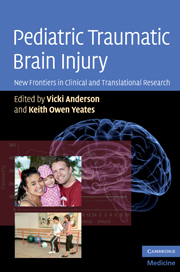Book contents
- Frontmatter
- Contents
- List of contributors
- Acknowledgments
- Introduction: Pediatric traumatic brain injury: New frontiers in clinical and translational research
- 1 Biomechanics of pediatric TBI
- 2 Neurobiology of TBI sustained during development
- 3 Using serum biomarkers to diagnose, assess, treat, and predict outcome after pediatric TBI
- 4 Clinical trials for pediatric TBI
- 5 Advanced neuroimaging techniques in children with traumatic brain injury
- 6 Neurobehavioral outcomes of pediatric mild traumatic brain injury
- 7 Very long-term neuropsychological and behavioral consequences of mild and complicated mild TBI: increased impact of pediatric versus adult TBI
- 8 Neurobehavioral outcomes of pediatric traumatic brain injury
- 9 Neuropsychological rehabilitation in children with traumatic brain injuries
- 10 Psychosocial interventions
- 11 Pediatric TBI: challenges for treatment and rehabilitation
- 12 Integrating multidisciplinary research for translation from the laboratory to the clinic
- Index
- Plate section
- References
9 - Neuropsychological rehabilitation in children with traumatic brain injuries
Published online by Cambridge University Press: 14 May 2010
- Frontmatter
- Contents
- List of contributors
- Acknowledgments
- Introduction: Pediatric traumatic brain injury: New frontiers in clinical and translational research
- 1 Biomechanics of pediatric TBI
- 2 Neurobiology of TBI sustained during development
- 3 Using serum biomarkers to diagnose, assess, treat, and predict outcome after pediatric TBI
- 4 Clinical trials for pediatric TBI
- 5 Advanced neuroimaging techniques in children with traumatic brain injury
- 6 Neurobehavioral outcomes of pediatric mild traumatic brain injury
- 7 Very long-term neuropsychological and behavioral consequences of mild and complicated mild TBI: increased impact of pediatric versus adult TBI
- 8 Neurobehavioral outcomes of pediatric traumatic brain injury
- 9 Neuropsychological rehabilitation in children with traumatic brain injuries
- 10 Psychosocial interventions
- 11 Pediatric TBI: challenges for treatment and rehabilitation
- 12 Integrating multidisciplinary research for translation from the laboratory to the clinic
- Index
- Plate section
- References
Summary
It is of importance to underline that traumatic brain injuries (TBI) in children affects cognitive, social, behavioral, and emotional functioning. Each of these domains interacts with the other, and need to be considered simultaneously within the field of neuropsychological rehabilitation (Sohlberg & Mateer, 2001). The goals of neuropsychological rehabilitation are to promote recovery and to work with the injured child and his/her family to compensate for residual deficits, to understand and treat cognitive, social, and behavioral impairments, to recognize the role of these impairments in functional disabilities, and to monitor and support the family in managing their child's needs. Working with the emotional reactions to frustration and loss is another integral part of effective treatment (Prigatano, 1999; Wilson, 2003; Ylvisaker, 1998; Ylvisaker & Feeney, 2002). Parents play a key role in the rehabilitation process and education for parents is essential in the rehabilitation program (Braga, 2000).
Plasticity versus vulnerability in brain development
Traumatic injury to the developing brain is distinct from adult traumatic brain injury in many ways. One major difference is that the developing brain is more plastic, often considered as an advantage with regard to recovery of function. However, children who suffer TBI are well known to develop chronic cognitive and behavioral disturbances (Taylor & Alden, 1997). Plasticity may be defined as a both structural and functional process (Dennis, 2000).
- Type
- Chapter
- Information
- Pediatric Traumatic Brain InjuryNew Frontiers in Clinical and Translational Research, pp. 169 - 178Publisher: Cambridge University PressPrint publication year: 2010

